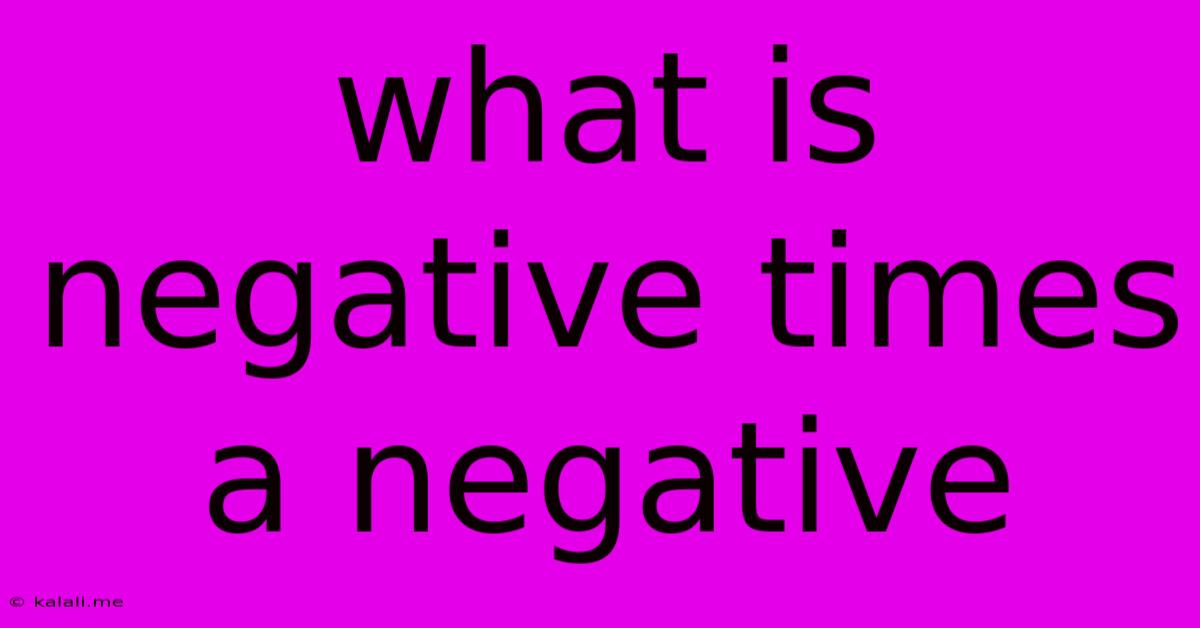What Is Negative Times A Negative
Kalali
Jun 05, 2025 · 3 min read

Table of Contents
What is Negative Times a Negative? Understanding the Rules of Multiplication
This article explores the often-confusing concept of multiplying negative numbers. We'll break down why a negative times a negative equals a positive, providing clear explanations and examples to solidify your understanding. Understanding this fundamental rule is crucial for mastering algebra and more advanced mathematical concepts.
Why does a negative times a negative equal a positive? This question stumps many, but the answer lies in understanding the properties of multiplication and the concept of negative numbers themselves. Let's explore several approaches to illustrate this:
1. The Number Line Approach
Imagine a number line. Multiplication can be seen as repeated addition. For example, 3 x 2 means adding 3 two times (3 + 3 = 6). Now consider -3 x 2. This means adding -3 two times (-3 + -3 = -6). This shows that a negative number multiplied by a positive number results in a negative number.
But what about -3 x -2? Let's think of this as the opposite of -3 x 2. Since -3 x 2 = -6, the opposite of -6 is +6. Therefore, -3 x -2 = 6. This demonstrates that the product of two negative numbers is positive.
2. The Pattern Approach
Let's look at a pattern:
- 3 x 2 = 6
- 3 x 1 = 3
- 3 x 0 = 0
- 3 x -1 = -3
- 3 x -2 = -6
Notice the pattern? As the second number decreases by 1, the product decreases by 3. Continuing this pattern:
- 3 x -3 = -9
- -3 x -2 = -(-6) = 6
This pattern clearly shows that multiplying two negative numbers results in a positive number. This applies regardless of the numbers involved – the rule remains consistent.
3. The Distributive Property Approach
The distributive property states that a(b + c) = ab + ac. Let’s use this to illustrate:
Let's consider the expression: -1( -a + a ). We know that -a + a = 0. Therefore:
-1(-a + a) = -1(0) = 0
Now, let's apply the distributive property:
-1(-a + a) = (-1)(-a) + (-1)(a) = (-1)(-a) - a = 0
Since the result must be zero, (-1)(-a) must be equal to 'a' for the equation to hold true. This proves that a negative number multiplied by a negative number results in a positive number.
Real-World Examples
While abstract, the concept has real-world applications. Think about removing debts (negative amounts). If you remove two debts of $5 each (-2 x -$5), you've effectively increased your net worth by $10 (+10). This illustrates how the rule of negative times negative equals positive translates to practical scenarios.
Conclusion
The rule that a negative times a negative equals a positive might seem counterintuitive at first. However, by understanding the concept through the number line, observing patterns, or applying the distributive property, we can see its logical consistency. This rule is fundamental to algebra and further mathematical studies, underpinning many more complex calculations and problem-solving techniques. Mastering this concept provides a strong foundation for future mathematical endeavors.
Latest Posts
Latest Posts
-
D O U B L E Words
Jun 07, 2025
-
How To Replace Heating Element In Water Heater
Jun 07, 2025
-
No Available Modular Metadata For Modular Package
Jun 07, 2025
-
Terrible Quality On Hdmi Cable Macbook
Jun 07, 2025
-
What Causes A Air Conditioner To Freeze Up
Jun 07, 2025
Related Post
Thank you for visiting our website which covers about What Is Negative Times A Negative . We hope the information provided has been useful to you. Feel free to contact us if you have any questions or need further assistance. See you next time and don't miss to bookmark.